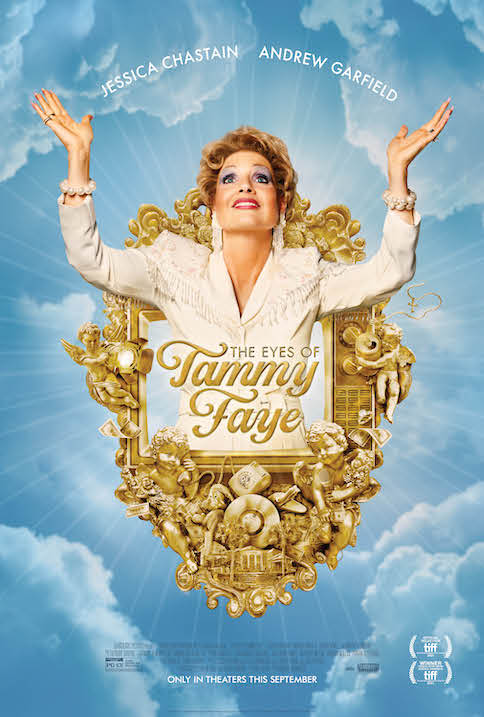‘The Eyes of Tammy Faye’ Seeks Out Redemption (Movie Review)
 This weekend, Searchlight Pictures’ dramatic adaptation of the similarly titled documentary from 2000, The Eyes of Tammy Faye, opens exclusively in theaters. The doc was narrated by RuPaul, while this film, at the very least, features a single lip sync for your life moment. It also sports a strong cast that includes Jessica Chastain as Tammy, Andrew Garfield as her husband Jim Bakker, and Vincent D’Onofrio in a smaller role as the larger-than-life Jerry Falwell. In their heyday, these three individuals were massively successful televangelists. Will that be enough to satisfy Tammy’s fans, especially in the LGBTQ community? Like 2017’s I, Tonya, director Michael Showalter is aiming for an empathetic look at Tammy Faye Bakker, a woman who might very well have been the lone advocate for the gay community during the AIDS crisis among the ultra right-winged Christians.
This weekend, Searchlight Pictures’ dramatic adaptation of the similarly titled documentary from 2000, The Eyes of Tammy Faye, opens exclusively in theaters. The doc was narrated by RuPaul, while this film, at the very least, features a single lip sync for your life moment. It also sports a strong cast that includes Jessica Chastain as Tammy, Andrew Garfield as her husband Jim Bakker, and Vincent D’Onofrio in a smaller role as the larger-than-life Jerry Falwell. In their heyday, these three individuals were massively successful televangelists. Will that be enough to satisfy Tammy’s fans, especially in the LGBTQ community? Like 2017’s I, Tonya, director Michael Showalter is aiming for an empathetic look at Tammy Faye Bakker, a woman who might very well have been the lone advocate for the gay community during the AIDS crisis among the ultra right-winged Christians.

Predominantly set during the 70s through the 90s, the script by Abe Sylvia, Fenton Bailey, and Randy Barbato follows the now-familiar rise and fall and possible rise again structure numerous biopics have used. We meet Tammy as a kid back in the 50s who’s an outcast in her small town. She’s not shy at all despite her mother (Cherry Jones) wishing she would be. Tammy, as a child, craves attention, sure, but not in a harmful way.
Flash forward to 1970: Tammy quickly takes a liking to Jim as they meet at a kind of “practice sermon.” Jim proclaims to churchgoers that God, by no uncertain terms, wants His people to live well. Money, cars, a good home all of this can be theirs if they simply follow His teachings. Of course, this is in direct opposition to the whole “bring me your poor” doctrine that Christianity typically proclaims as gospel. But Jim and his soon-to-be wife Tammy can’t fathom a world where having everything they want isn’t some kind of divine inheritance. A few puppet shows later (not kidding), and Jim and Tammy have 20 million viewers via their own Christian television network, the PTL. But wouldn’t ya know it, it turns out millions of dollars in donations went to funding the Bakker’s lavish lifestyles while their non-profit organizations kept going in the red.
The real hook of Tammy Faye is the outlandish personality of Tammy herself. Yes, the make-up used to get Chastain closer to the real Tammy’s visage distracts for the first twenty minutes, but eventually, Chastain’s dedication as a performer shines through. She can seem cartoony or crazily naive, but Tammy, the person (by way of this dramatic interpretation), had her own insecurities despite putting on a literal happy face every night for two decades on live TV. In private, like in most biopics, the home life of America’s favorite bible-thumpers was sad and depressing. The challenge for the film is whether we’ll feel for two people that seemingly took millions from others, many of whom were poor.

The solution, or sidestep if you will, is to only focus on the “nearly 100 million in fraud” plot when the narrative needs to remind us, yeah, these are not good people. Roger Ebert famously said that cinema is a great empathy machine. By way of peeling under the layers of makeup, Chastain absolutely makes us invested and, yes, care for Tammy despite our own best judgment. Part of this is the optics of seeing a charismatic woman completely isolated among rich, powerful men. Another part of this is how Tammy, on her bests days, loves to bring her brand of happiness to everyone she meets. Chastain’s performance isn’t effortless, but it’s no less convincing.
As mentioned at the top, Tammy Faye Bakker really did have a young man living with HIV on her show in 1985. Despite Falwell and pretty much all the other white dudes in power at the PTL, she threw out a lifeline to the gay community. The scene in which Tammy talks to Steve Pieters via a TV about his diagnosis and being gay convinces and displays a woman who had plenty of empathy herself. Later, when Tammy is at her lowest and has her aforementioned lip sync for her life moment, a clever bit of staging gave me plenty to care about.
Is that enough? I think it can be to a degree. I wish the script dived in more to Jim’s life as a man who may have been living in the closet. And while I’m not saying Tammy needs a Jim Morrison drug fest a la The Doors, her dependency on pills as covered in the film is pretty standard Lifetime tv fare. I think there’s a much more honest version of this story (perhaps in some multiverse?), but as it stands, I think fans of Tammy will be pleased.
![]()
![]()
![]()
![]()
![]()


















